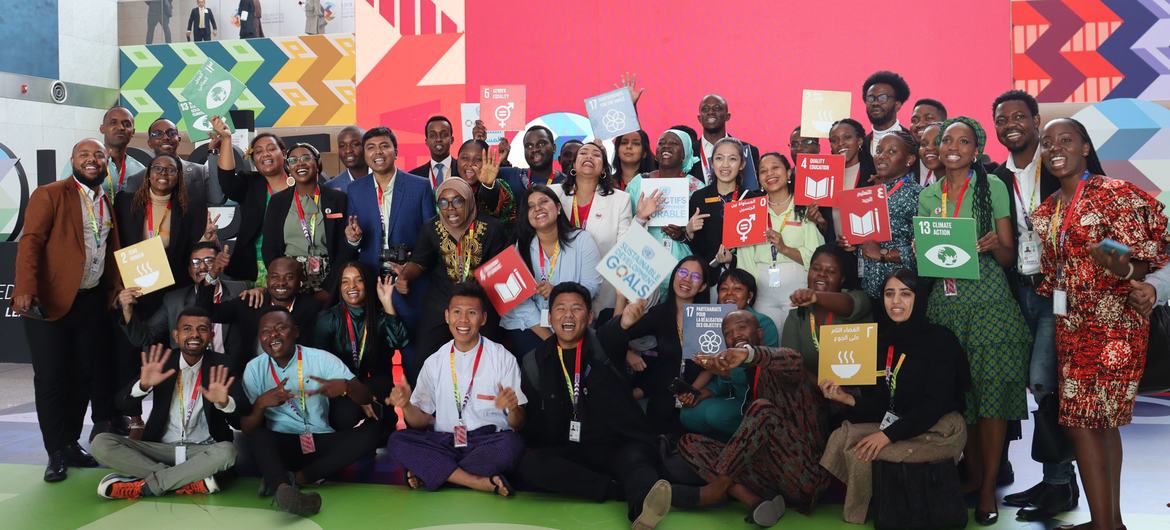
1. What is the Summit of the Future?
In 2020, the UN turned 75 and marked the occasion by starting a global conversation about hopes and fears for the future.
This was the beginning of a process that would eventually lead, four years later, to the convening of the Summit of the Future, a major event this September, which will take place at UN Headquarters, just before the annual high-level debate of the General Assembly.
The Summit was conceived at the height of the COVID-19 pandemic, when there was a perception at the UN that, rather than cooperating to face this global threat that affected all of us, countries and people pulled apart.
“We were really confronted with the gap between the aspirations of our founders, which we were trying to celebrate at the 75th anniversary, and the reality of the world as it is today”, says Michele Griffin, the Policy Director of the Summit. “The problems that we faced, the threats, but also the opportunities and the imperfections in how we respond”.
UN Member States tasked Secretary-General António Guterres to come up with a vision for the future of global cooperation. His answer to their call was “Our Common Agenda”, a landmark report with recommendations on renewed global cooperation to address a host of risks and threats, and a proposal to hold a forward-looking summit in 2024.
The event will consist of sessions and plenaries based around five main tracks (sustainable development and financing; peace and security; a digital future for all; youth and future generations; and global governance), and other topics that cut across all of the work of the UN, including human rights, gender equality and the climate crisis.
The immediate outcome will be a finalised version of a Pact for the Future, with a Global Digital Compact and a Declaration for Future Generations in annex, all of which are expected to be adopted by Member States during the Summit.
2. Why does the Summit matter?
Because, although these themes have been addressed in the past, and groundbreaking accords such as the Paris Agreement on climate and the Sustainable Development Goals have been reached, there is a widespread perception that the structures of the UN, many of which were established decades ago, are no longer sufficiently fair or effective.
The Summit of the Future offers a chance to deliver more fully on promises that have already been made, to ready the international community for the world to come, and to restore trust.
“The most important ingredient in international cooperation is trust”’ says Michele Griffin. “Trust in each other. A sense of our shared humanity, our interconnectedness. And the summit is designed to remind all of us, not just governments and not just people who will be at the UN in New York in September, but everyone, that we have to work together to solve our biggest shared problems”.

3. Who are the key players?
The Summit will be preceded by two Action Days, also held at UN Headquarters, where representatives from civil society, private sector, academia, local and regional authorities, youth, Member States and many more, will have the chance to engage in the main themes of the event.
“You look at the UN and you think governments are the key players”, says Griffin. “And that’s true. They’re the ones sitting around the table, but they do so on behalf of their people”.
“Civil society actors, young people have been involved throughout and will be at the summit”, explains Ms. Griffin. “Private sector will be here in recognition of the massive role they have in shaping people's lives and opportunities today. This summit is for and by everyone, and everyone should see themselves reflected in it”.

4. What happens next?
The organizers of the Summit have stressed that the closing of the event will not be the end of the discussions and issues raised over the four days.
Michele Griffin describes it as the beginning of a process: “most of the seeds that we plant at this summit will take some time to grow and flourish”, she says, “and all of us have to be involved in holding governments responsible for living up to their commitments on the international stage”.
After the Summit, the focus will shift to implementing the recommendations and pledges contained within the Pact for the Future. In November, Azerbaijan will host the UN Climate Conference (COP29), where climate financing will be high on the agenda; December sees the UN Conference on Landlocked Developing Countries in Botswana, where solutions for sustainable development will be sought; and next June, efforts to reform the international financial architecture (including bodies such as the World Bank and International Monetary Fund, which decide how, and under which conditions, to provide loans, grants and technical assistance to developing countries) will be stepped up in Spain, at the International Conference on Financing for Development (Ffd4).

5. How can I get involved?
Act Now is the UN’s global campaign to encourage all people to advocate for a better, more peaceful and sustainable future. The platform aims to increase the numbers of those who are speaking up and making a positive difference, whether it’s by volunteering in their local community, taking part in local decision-making, or simply changing their personal habits of consumption to live more environmentally responsible lives.
In the lead up to the Summit, the UN Youth Office is also galvanizing young people and allies by launching #YouthLead, an appeal to world leaders to make global policymaking more representative of the communities they serve.
Source: UN News
 Welcome to the United Nations
Welcome to the United Nations


